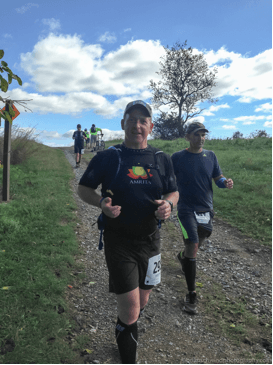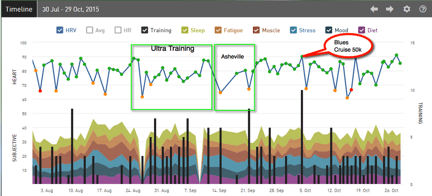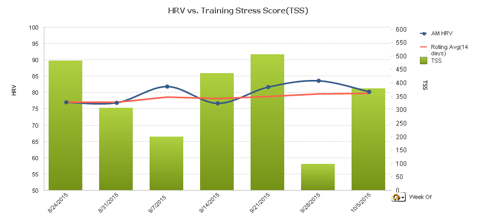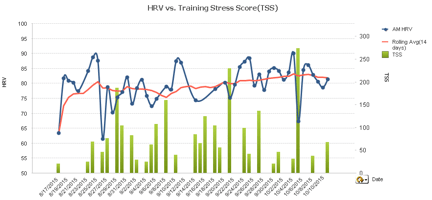With my last race of the season completed I headed into September and October with the main goal of recovery and rejuvenation. My focus is spending more time with my wife, getting outside and doing some different activities, and just enjoying some free time. I have still been wearing my HRM and GPS watch to track my workouts, but there are no goal times or zones to be had. Just get out, have fun and enjoy yourself. I continued to monitor my Heart Rate Variability (HRV) every morning, but I honestly have not looked at how it has been trending for the last couple months. At least until I sat down to write this post.
So, what does  any typical triathlete do for off-season fun? They sign up for a 50k ultra trail run of course! There is a local 50k trail run, called the Blue Cruise 50k, which circumnavigates Blue Marsh Lake near Reading, PA via a mountain bike trail. I have mountain biked the 30-mile trail several times in the past, which left me pretty exhausted. Now I was going to run it. To make this more challenging, I only decided to do this 6 weeks out from the event after 4 weeks of very minimal activity since my last triathlon.
any typical triathlete do for off-season fun? They sign up for a 50k ultra trail run of course! There is a local 50k trail run, called the Blue Cruise 50k, which circumnavigates Blue Marsh Lake near Reading, PA via a mountain bike trail. I have mountain biked the 30-mile trail several times in the past, which left me pretty exhausted. Now I was going to run it. To make this more challenging, I only decided to do this 6 weeks out from the event after 4 weeks of very minimal activity since my last triathlon.
I had already gained back 10 lbs from my race weight which would not be of much help. I had no real time goals for this event. I just wanted to run the distance and enjoy the scenery. My only real goal was to let my legs think that 26.2 miles is not such a big deal anymore after doing 31 on trails, up-and-down may hills.
I immediately got back to a more routine training schedule with the limited time I had. Fortunately, I was well rested so I didn’t need too much recovery time in the six weeks before. My weekly training consisted of a shorter(1:00-1:1:15), but more intense, technical trail run at the local ski area MTB trails one day, a longer(1:20-1:30) but less technical trail run another day, and then a long, slow(LSD) run on Saturday. The long run started at around 3 hours the first week and increased each week up to about 4.5 hours, before the final taper week. I would usually throw in another shorter run on Sunday, just to get used to running on tired legs. I also filled in the other days with some mountain biking, road biking, or stand-up paddle boarding.
We also had a vacation planned to go down to Asheville, NC on the fourth week of my training. Usually, a vacation would tend to reduce training time, but Asheville is an outdoor activity mecca and I was able to get some extra training down there. The Bent Creek Experimental Forest area south-west of the city has miles of excellent trails for mountain biking and trail running.
Based on the timeline above, my HRV was mostly in the 75-90 range during the last 3 months except for some occasional drop down to the 60’s here and there. One thing that is notable is that once I started training again my HRV gradually started increasing again. The few HRV readings I was able to obtain while in Asheville are probably a bit invalid since I was having some technical difficulties with my phone during that week.
Missing those readings during vacation may have been a good thing in disguise. Asheville is affectionately known as “Beer City” due to the amount of micro-breweries there and I made a point of sampling as many of them as I could. Beer doesn’t really provide for good Heart Rate Variability scores.
After returning from our Asheville vacation, my readings stayed pretty consistent between 80-90 for the next two weeks and peaked out at 90 the day of the Blues Cruise 50k ultra. I guess I was ready. Despite the limited in training time, I was able to integrate enough recovery time into my routine by monitoring my daily HRV reading and not just blindly taking an entire week. HRV is such a great tool for determining when your body needs recovery. As opposed to just applying some generic periodised plan that is developed by the masses. You can surely maximise your training time effectively by monitoring HRV.
Daily HRV vs. TSS during Ultra Training
Daily HRV vs. TSS during Ultra Training
So what does a 31 mile/50k ultra do to your HRV? For me, it drops it like a sack of potatoes! The Blues Cruise 50k Ultra was a great event. I was a little slower than I thought, but I didn’t have that many expectations other than just enjoying it. You can read more details about the race on my race report blog post here. As you can see from the chart above, my HRV on the morning after my ultra had dropped down to 67 and I surely felt that way too (Each Training Stress Score(TSS) in the chart is from the day prior). I was pretty sore that next day and a bit fatigued. Fortunately, 24 hours later things were back to normal, but I still took it easy the week following.
Developing a New Early Morning Habit
Now that I am done with all my races for the year (I mean it this time!) and am well recovered, I am starting up the building process for next season from the ground up. I have started working with a strength coach, Fernando Paredes, who is developing a series custom routines to address all of my weak areas. I always struggle to find the time to do my strength work, so I made a commitment to myself to establish a more consistent habit of this.
I recently came across a book called, The Miracle Morning by Hal Elrod, which has changed my world. I have NEVER been an early morning riser and despite numerous attempts to become one, they have all been short-lived and fail. I don’t know what it is about the techniques in this book, but I have been getting up at 5 am every weekday (6 am on weekends) for the past 26 days now and completing my strength training routine.
Now I am in my fourth week of consistent strength work, I am really starting to feel the foundations being built with a more solid core. So many professional and elite triathletes swear about how strength work has helped them in achieving amazing performance, so I figure this might be the edge I need to get me under that 12 hour Ironman finish I desire.
 Looking at the 1st graph at the top of the post, you can see that my HRV is also mostly trending upward since I have started this new routine. The few low readings you see were while I was fighting a sinus head cold due to the recently fluctuating temperatures here in the eastern US. Fortunately, I was able to beat it and get back to normal. In addition to strength training, I have been getting out for some biking and running as well. Nothing too intense this time of year, but just enough to keep the wheels in motion. I have also been making an effort to get out on the trails running or mountain biking and taking in the colours of the Fall season. Even though they call it the “off” season, there is not much “off” to it. Just a different type of intention to how you are training. Till next time!
Looking at the 1st graph at the top of the post, you can see that my HRV is also mostly trending upward since I have started this new routine. The few low readings you see were while I was fighting a sinus head cold due to the recently fluctuating temperatures here in the eastern US. Fortunately, I was able to beat it and get back to normal. In addition to strength training, I have been getting out for some biking and running as well. Nothing too intense this time of year, but just enough to keep the wheels in motion. I have also been making an effort to get out on the trails running or mountain biking and taking in the colours of the Fall season. Even though they call it the “off” season, there is not much “off” to it. Just a different type of intention to how you are training. Till next time!



